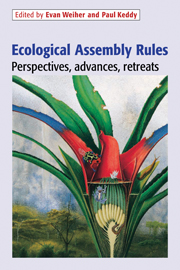Book contents
- Frontmatter
- Contents
- List of Contributors
- Introduction: The scope and goals of research on assembly rules
- Part I The search for meaningful patterns in species assemblages
- Part II Other perspectives on community assembly
- 8 On the nature of the assembly trajectory
- 9 Assembly rules as general constraints on community composition
- 10 A species-based, hierarchical model of island biogeography
- 11 Interaction of physical and biological processes in the assembly of stream fish communities
- 12 Functional implications of trait–environment linkages in plant communities
- 13 When does restoration succeed?
- 14 Epilogue: From global exploration to community assembly
- Index
10 - A species-based, hierarchical model of island biogeography
Published online by Cambridge University Press: 04 September 2009
- Frontmatter
- Contents
- List of Contributors
- Introduction: The scope and goals of research on assembly rules
- Part I The search for meaningful patterns in species assemblages
- Part II Other perspectives on community assembly
- 8 On the nature of the assembly trajectory
- 9 Assembly rules as general constraints on community composition
- 10 A species-based, hierarchical model of island biogeography
- 11 Interaction of physical and biological processes in the assembly of stream fish communities
- 12 Functional implications of trait–environment linkages in plant communities
- 13 When does restoration succeed?
- 14 Epilogue: From global exploration to community assembly
- Index
Summary
Introduction
MacArthur and Wilson's (1963, 1967) Equilibrium Theory has served as a paradigm for the field of ecological biogeography for nearly three decades (see also Munroe, 1948, 1953; Brown & Lomolino, 1989). The theory provided an insightful alternative to the prevailing, ‘static theory’ of island biogeography (see Dexter, 1978), which held that insular community structure was fixed in ecological time, resulting from unique immigration and extinction events. Either a species made it to the island in question, or it did not. Once it arrived, the species found adequate resources for survival, and did so in perpetuity, or it failed to establish a population. In contrast, MacArthur and Wilson held that insular community structure was dynamic in ecological time, resulting from recurrent immigrations and extinctions. As an island filled with species, immigration rate declined and extinction rate increased until an equilibrial number of species was attained. At this level, species richness would remain relatively constant, while species composition would continue to change as new species replaced those becoming extinct.
MacArthur and Wilson (1967: 19–21) acknowledged that ‘a perfect balance between immigration and extinction might never be reached, … but to the extent that the assumption of a balance has enabled us to make certain valid new predictions, the equilibrium concept is useful’. The equilibrium theory has indeed served as a worthy paradigm, stimulating much research on structure of isolated communities.
- Type
- Chapter
- Information
- Ecological Assembly RulesPerspectives, Advances, Retreats, pp. 272 - 310Publisher: Cambridge University PressPrint publication year: 1999
- 15
- Cited by



